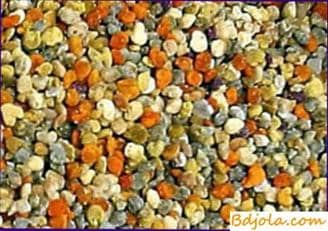
In addition to the liquid phase, honey is always found in microscopic solid particles – pollen grains, which, despite cleaning in honey cind, get into honey together with nectar. Since each plant species has its size, shape and color of the pollen grains, it is possible to determine from the pollen contained in honey, from which plants nectar is collected. Pollen analysis of honey is the main objective method, which makes it possible to judge with sufficient certainty the botanical origin of honey.
The honey also gets the pollen shaken in the hive from the surface of the body of young bees, which are not yet flying out for collecting nectar. In the experiment sugar beet syrup was fed to the bees, which, naturally, did not have pollen grains. However, 900 pollen grains per 1 g of honey were found in the sealed sugar supply cells. Therefore, in honey, obtained from the nectar of only one plant, there is always a small admixture of pollen and other plants, but the pollen of the main plant always clearly prevails.
A sample of honey obtained from buckwheat nectar contains 50 to 500 pollen grains in 1 g. Most of the 1 honey contains about 1 000 g of pollen grains. But there are honey, containing a lot of pollen grains: for example, in 1 gram of heather honey there are an average of 8500 grains; occasionally there are honey (apparently poorly peeled in honey cinders) containing up to 28,000 grains in 1 g.
The presence of a large number of pollen grains in honey adversely affects the wintering of bees. Pollen grains not only serve as ballast, loading their intestines, but also accelerate the crystallization of honey; for example, honey, obtained from the nectar of cruciferous plants, for this reason is completely unsuitable for the wintering of bees. On the contrary, the wintering of bees is particularly successful in honey with a small number of grains (linden, white acacia, buckwheat).
To determine the botanical origin of honey, weigh 10 g of honey, pour 20 ml of distilled water, stir. The solution is centrifuged, a drop is taken from the precipitate on a slide and distributed uniformly on a 1.5 cm2 plane, covered with a slide, counted under a microscope the number of grains and determine whether they belong to the plant species. According to the prevailing pollen, the botanical origin of honey is judged. If there is no clearly prevailing pollen, then this is an indicator of the mixed origin of honey.
Выкачка меда когда. Что делать с опоношенными рамками с медом.
Feeding base of beekeeping